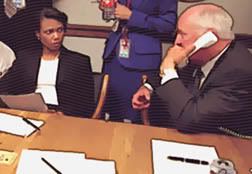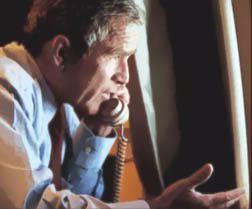They Let It Happen
last updated 5/7/07
A year after the attack, CNN retold Vice President Cheney’s version of what happened. Cheney was in his proper office in the West Wing when he heard that a plane had crashed into the WTC. Unlike everyone else whose reactions I’ve looked at - with the notable exception of counter-terrorism “Czar” Richard Clarke - Cheney had an inkling this may not be a simple accident. “He watched TV and hoped that his instincts were wrong.,” CNN reported. He explained “it was a clear day, there were no weather problems, and then we saw the second airplane hit in real time. At that moment, you knew this was a deliberate act. This was a terrorist act.” [1]
Shortly after this, his Secret Service agent “all of a sudden materialized right beside me and said, 'Sir, we have to leave now.' He grabbed me and propelled me out of my office, down the hall, and into the underground shelter in the White House." [2] So while, as many noted, the Secret Service was allowing the President to linger in the open at the schoolhouse, they were “propelling” Cheney to safety in an underground bunker. While both men were on the East Coast, they seemed to be operating in two different time zones.
This underground shelter was the Presidential Emergency Operations Center (PEOC). From the previously unused but well-equipped PEOC, as CNN explains, the Vice-President “directed the U.S. government's response” to the attack. The actions Cheney took “included moving key members of Congress to a secure location and having the Secret Service bring his wife, Lynn, to the bunker.” [3] Somehow, these radical moves failed to halt the attack.
 |
But we know he was in the presence of Secret Service agents during the entire crisis, and the evidence indicates their communication abilities were widespread and efficiently used. Cheney seemed to slip on this once, telling Meet the Press, on September 16 “the Secret Service has an arrangement with the FAA. They had open lines after the World Trade Center was ...” [6] He cut himself off there and shifted gears. What this means is that after the first plane hit, and we would presume soon after, the Secret Service knew, and were listening in on, at least, the FAA’s communications by about 8:50. The second plane was already confirmed hijacked by FAA and NORAD and headed to New York by this time.
Richard Clarke also testified in his book Against All Enemies that at about 9:40, Brian Stafford, Director of the Secret Service “slipped me a note. “Radar shows aircraft headed this way.’” Clarke explained “Secret Service had a system that allowed them to see what FAA’s radar was seeing.” [7] The 9/11 Commission also has backed up direct Secret-Service-FAA communications in their final report. [8] The Secret Service knew all these things and were just a “hey, you!” away from Cheney’s ear and Bush’s.
The communication abilities of the Secret Service also, apparently, extended into the military chain of command, their contacts to the very front lines of the battle. Recall that it was the Secret Service who called the Langley fighter pilots around 9:55 and told them to “protect” the White House (though with no mention of precisely how). [9] They also called Andrews Air Force Base, near the Pentagon, shortly after 9:03 to request fighter jets, which didn’t get any off the ground until 10:42. [10]
 |
[1], [2], [3], [5] “Cheney recalls taking charge from bunker.” CNN. September 12, 2002. Accessed at: http://archives.cnn.com/2002/ALLPOLITICS/09/11/ar911.king.cheney/
[4] 9/11 Commission Final Report. Page 40.
[6] Thompson and the CCR. "The Terror Timeline." Page 375.
[7] Ruppert, "Crossing the Rubicon." Page 427.
[8] 9/11 Commission Final Report. Page 41.
[9] Thompson and the CCR. "The Terror Timeline." Page 436.
[10] Thompson and the CCR. Page 458.



2 comments:
The readers of CAUSTIC LOGIC can advance their cause by recommending THE TERROR TIMELINE by Paul Thompson to their friends as well as their local libraries. It is the factual base that empowers those seeking the full truth of 9/11.
I fully endorse this unrequested spam ;)
The Terror timeline is a great resource for those seeking the truth, like ME! It was well worth the $$ spent.
Post a Comment